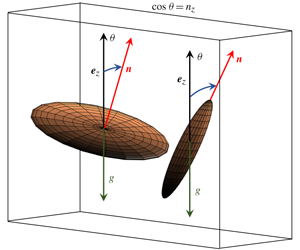Crossref Citations
This article has been cited by the following publications. This list is generated based on data provided by
Crossref.
Fröhlich, Konstantin
Meinke, Matthias
and
Schröder, Wolfgang
2020.
Correlations for inclined prolates based on highly resolved simulations.
Journal of Fluid Mechanics,
Vol. 901,
Issue. ,
Ishimoto, Kenta
2020.
Jeffery orbits for an object with discrete rotational symmetry.
Physics of Fluids,
Vol. 32,
Issue. 8,
Fröhlich, Konstantin
Farmand, Pooria
Pitsch, Heinz
Meinke, Matthias
and
Schröder, Wolfgang
2021.
Particle Reynolds number effects on settling ellipsoids in isotropic turbulence.
International Journal of Multiphase Flow,
Vol. 139,
Issue. ,
p.
103566.
Will, Jelle B.
Mathai, Varghese
Huisman, Sander G.
Lohse, Detlef
Sun, Chao
and
Krug, Dominik
2021.
Kinematics and dynamics of freely rising spheroids at high Reynolds numbers.
Journal of Fluid Mechanics,
Vol. 912,
Issue. ,
Li, Si-Wei
Lin, Po-Hsu
Ho, Tung-Yuan
Hsieh, Chih-hao
and
Sun, Chen-li
2021.
Change in rheotactic behavior patterns of dinoflagellates in response to different microfluidic environments.
Scientific Reports,
Vol. 11,
Issue. 1,
Trunk, Robin
Bretl, Colin
Thäter, Gudrun
Nirschl, Hermann
Dorn, Márcio
and
Krause, Mathias J.
2021.
A Study on Shape-Dependent Settling of Single Particles with Equal Volume Using Surface Resolved Simulations.
Computation,
Vol. 9,
Issue. 4,
p.
40.
Gustavsson, K.
Sheikh, M. Z.
Naso, A.
Pumir, A.
and
Mehlig, B.
2021.
Effect of Particle Inertia on the Alignment of Small Ice Crystals in Turbulent Clouds.
Journal of the Atmospheric Sciences,
Vol. 78,
Issue. 8,
p.
2573.
Jiang, F.
Zhao, L.
Andersson, H. I.
Gustavsson, K.
Pumir, A.
and
Mehlig, B.
2021.
Inertial torque on a small spheroid in a stationary uniform flow.
Physical Review Fluids,
Vol. 6,
Issue. 2,
Bretl, Colin
Trunk, Robin
Nirschl, Hermann
Thäter, Gudrun
Dorn, Marcio
and
Krause, Mathias J.
2021.
High Performance Computing in Science and Engineering '20.
p.
245.
Zhong, Haichao
and
Xie, Li
2021.
Depolarization of microwave by sand-dust particles in atmospheric turbulence.
Journal of Quantitative Spectroscopy and Radiative Transfer,
Vol. 266,
Issue. ,
p.
107603.
Wang, Bohan
Jiang, Weiquan
and
Chen, Guoqian
2022.
Cross-channel distribution and streamwise dispersion of micro-swimmers in a vertical channel flow: A study on the effects of shear, particle shape, and convective inertial torque.
Physics of Fluids,
Vol. 34,
Issue. 1,
Qiu, Jingran
Cui, Zhiwen
Climent, Eric
and
Zhao, Lihao
2022.
Gyrotactic mechanism induced by fluid inertial torque for settling elongated microswimmers.
Physical Review Research,
Vol. 4,
Issue. 2,
Wang, Bohan
Jiang, Weiquan
and
Chen, Guoqian
2022.
Gyrotactic trapping of micro-swimmers in simple shear flows: a study directly from the fundamental Smoluchowski equation.
Journal of Fluid Mechanics,
Vol. 939,
Issue. ,
Shim, Hyoeun
and
Lee, Changhoon
2022.
Effect of gravity-induced fluid inertia on the accumulation and dispersion of motile plankton settling weakly in turbulence.
Physics of Fluids,
Vol. 34,
Issue. 8,
Cabrera-Booman, F.
Sheikh, M. Z.
Mehlig, B.
Plihon, N.
Bourgoin, M.
Pumir, A.
and
Naso, A.
2022.
Experimental validation of fluid inertia models for a cylinder settling in a quiescent flow.
Physical Review Fluids,
Vol. 7,
Issue. 2,
Dahlkild, Anders A.
2023.
Particle orientation distribution in a rotating, dilute suspension of rod-shaped particles.
Journal of Fluid Mechanics,
Vol. 954,
Issue. ,
Strathmann, RR
2023.
Perils of drifting encapsulated embryos of the periwinkle Littorina scutulata from failures at launch and unscheduled landings.
Marine Ecology Progress Series,
Vol. 703,
Issue. ,
p.
109.
Cui, Zhiwen
Qiu, Jingran
Jiang, Xinyu
and
Zhao, Lihao
2023.
Effect of fluid inertial torque on the rotational and orientational dynamics of tiny spheroidal particles in turbulent channel flow.
Journal of Fluid Mechanics,
Vol. 977,
Issue. ,
Saccone, D.
De Marchis, M.
Milici, B.
and
Marchioli, C.
2023.
Transport of inertial ellipsoidal particles in turbulent flow over rough walls.
Physical Review Fluids,
Vol. 8,
Issue. 8,
Li, Yansong
Xu, Chunxiao
and
Zhao, Lihao
2023.
Fluid-inertia torque on spheroids in pseudo-plastic fluid flows: effect of shear-thinning rheology.
Journal of Fluid Mechanics,
Vol. 970,
Issue. ,



